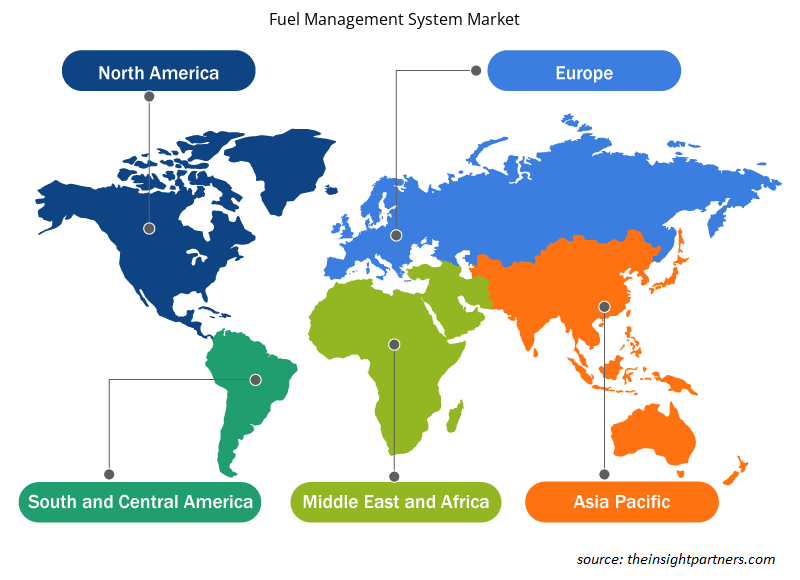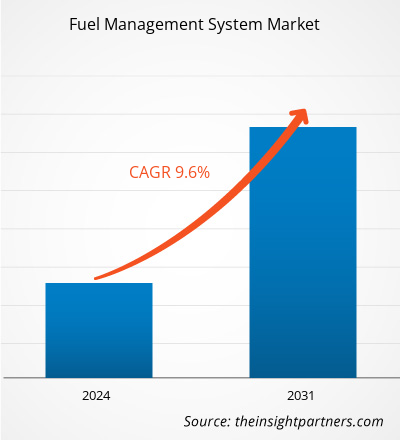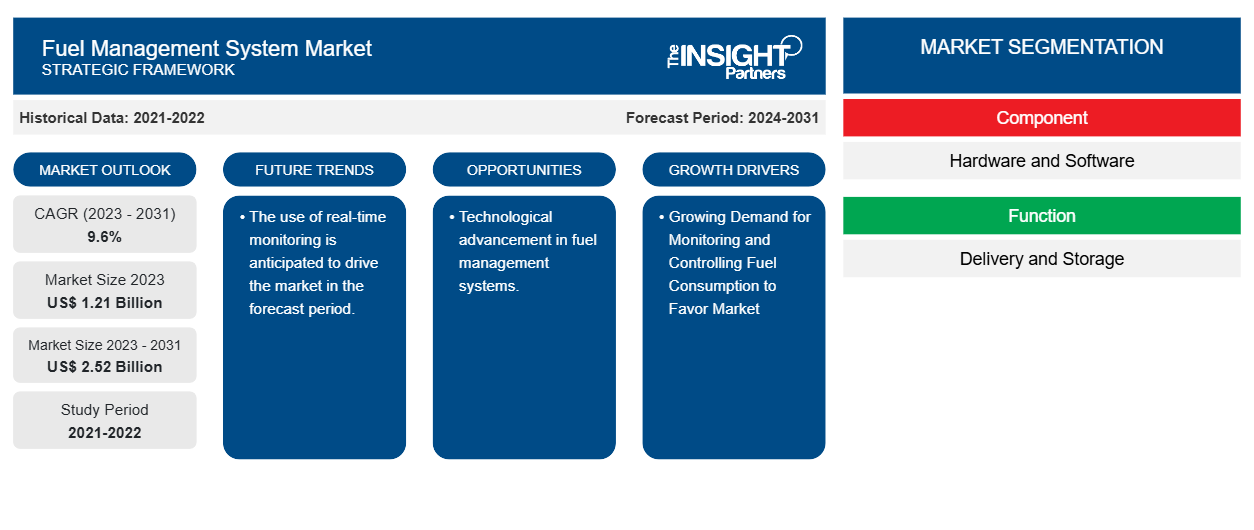연료 관리 시스템 시장 규모는 2023년 12억 1,000만 달러에서 2031년 25억 2,000만 달러로 성장할 것으로 예상됩니다. 이 시장은 2023~2031년 동안 9.8%의 CAGR을 기록할 것으로 예상됩니다. 연료 소비를 모니터링하고 제어하는 데 대한 수요 증가와 연료 도난 사례 증가는 시장의 주요 추세로 남을 가능성이 높습니다.CAGR of 9.8% during 2023–2031. Increasing demand for monitoring and controlling fuel consumption and increasing cases of fuel theft are likely to remain key trends in the market.
연료 관리 시스템 시장 분석
연료 관리 시스템 시장에 대한 수요는 여러 산업에서 생산성과 효율성을 개선하기 위한 더 나은 연료 관리에 대한 필요성이 증가함에 따라 증가할 것으로 예상됩니다. 게다가 더 나은 고객 경험을 제공하기 위한 전자 상거래 플랫폼의 급속한 성장은 공급 및 물류 산업이 IoT 산업을 강화하도록 이끌었습니다.IoT industries.
연료 관리 시스템 시장 개요
연료 관리 시스템은 운송, 건설 및 에너지 산업과 같은 다양한 응용 분야에서 연료 소비를 모니터링, 제어 및 최적화하는 데 사용되는 소프트웨어 및 하드웨어 기술의 한 유형입니다. 차량에서 연료 관리 시스템은 연료 소비, 엔진 성능 및 기타 요소를 모니터링하여 연료가 효율적으로 사용되고 있는지 확인하는 데 도움이 될 수 있습니다. 이를 통해 연료 비용을 줄이고 운영 효율성을 높이며 배출량을 줄이는 데 도움이 될 수 있습니다.
귀하의 요구 사항에 맞게 이 보고서를 사용자 정의하세요
이 보고서의 일부 또는 국가 수준 분석, Excel 데이터 팩을 포함하여 모든 보고서에 대한 사용자 정의를 무료로 받을 수 있으며 신생 기업 및 대학을 위한 훌륭한 혜택과 할인 혜택을 이용할 수 있습니다.
-
이 보고서의 주요 시장 동향을 알아보세요.이 무료 샘플에는 시장 동향부터 추정 및 예측까지 다양한 데이터 분석이 포함됩니다.
연료 관리 시스템 시장 동인 및 기회
시장을 선호하기 위한 연료 소비 모니터링 및 제어에 대한 수요 증가
연료 소비량을 모니터링하고 제어하는 데 대한 수요가 증가함에 따라 연료 관리 시스템 시장이 성장하고 있습니다. 연료 소비량을 모니터링하는 데는 여러 가지 이점이 있기 때문입니다. 비용 절감, 비효율성 식별, 배출량 감소 등과 같은 이점이 있습니다. 또한 실시간 연료 소비량 모니터링에 대한 수요도 증가하고 있습니다. 이를 통해 기업은 사후가 아닌 발생하는 대로 연료 낭비를 식별하고 해결할 수 있습니다. 이를 통해 기업은 실시간으로 연료 소비량과 비용을 줄일 수 있으며, 이는 최종 이익에 상당한 영향을 미칠 수 있습니다. 연료 소비량을 모니터링하고 제어하는 데에는 여러 가지 이점이 있으므로 연료 관리 시스템에 대한 수요가 많습니다.
연료 관리 시스템의 기술적 발전.
연료 관리 시스템의 기술적 발전은 여러 기회를 제공합니다. IoT 통합, 예측 분석, 머신 러닝 알고리즘, 투명성을 위한 블록체인, 에너지 효율적인 차량 등과 같은 기술적 발전. 이러한 발전은 물류 및 운송, 제조 및 공급망, 농업, 건설, 차량 관리 및 서비스 등 여러 산업에 도움이 될 수 있습니다. 따라서 다양한 산업의 기술적 발전은 연료 관리 시스템에 대한 수요를 증가시킵니다.IoT integration, predictive analytics, machine learning algorithms, blockchain for transparency, energy-efficient
연료 관리 시스템 시장 보고서 세분화 분석
연료 관리 시스템 시장 분석에 기여한 주요 세그먼트는 구성 요소, 기능 및 최종 사용자입니다.
- 구성 요소를 기준으로 연료 관리 시스템 시장은 하드웨어와 소프트웨어로 구분됩니다. 소프트웨어 부문은 예측 기간 동안 상당한 시장 점유율을 차지할 것으로 예상됩니다.
- 기능에 따라 연료 관리 시스템 시장은 배달 및 보관으로 구분됩니다. 배달 부문은 예측 기간 동안 상당한 시장 점유율을 차지할 것으로 예상됩니다.
- 최종 사용자별로 시장은 광업, 건설 및 항구, 운송 및 물류, 석유 및 가스, 기타로 세분화됩니다. 광업 부문은 예측 기간 동안 상당한 시장 점유율을 차지할 것으로 예상됩니다.
지역별 연료 관리 시스템 시장 점유율 분석
연료 관리 시스템 시장 보고서의 지리적 범위는 주로 북미, 아시아 태평양, 유럽, 중동 및 아프리카, 남미 및 중부 아메리카의 5개 지역으로 나뉩니다.
북미는 연료 관리 시스템 시장을 지배해 왔습니다. 북미 지역의 다양한 산업에서 첨단 기술 도입 추세가 연료 관리 시스템 시장의 성장을 촉진했습니다. 디지털 도구의 도입 증가와 정부 기관의 첨단 기술 지출과 같은 요인이 북미 연료 관리 시스템 시장 성장을 견인할 것으로 예상됩니다. 게다가 미국과 캐나다의 선진 경제권에서 연구 개발에 중점을 두면서 북미 업체는 기술적으로 진보된 솔루션을 시장에 내놓을 수밖에 없습니다. 게다가 미국에는 혁신적인 솔루션 개발에 점점 더 주력하고 있는 많은 연료 관리 시스템 시장 업체가 있습니다. 이러한 모든 요인이 이 지역의 연료 관리 시스템 시장 성장에 기여합니다.fuelled the growth of the fuel management system market. Factors such as increased adoption of digital tools and high technological spending by government agencies are expected to drive the North American fuel management system market growth. Moreover, a strong emphasis on research and development in the developed economies of the US and Canada is forcing the North American players to bring technologically advanced solutions into the market. In addition, the US has many fuel management system market players who have been increasingly focusing on developing innovative solutions. All these factors contribute to the region's growth of the fuel management system market.
연료 관리 시스템 시장 지역 통찰력
Insight Partners의 분석가들은 예측 기간 동안 연료 관리 시스템 시장에 영향을 미치는 지역적 추세와 요인을 철저히 설명했습니다. 이 섹션에서는 북미, 유럽, 아시아 태평양, 중동 및 아프리카, 남미 및 중미의 연료 관리 시스템 시장 세그먼트와 지리에 대해서도 설명합니다.

- 연료 관리 시스템 시장에 대한 지역별 특정 데이터를 얻으세요
연료 관리 시스템 시장 보고서 범위
| 보고서 속성 | 세부 |
|---|---|
| 2023년 시장 규모 | 12억 1천만 달러 |
| 2031년까지 시장 규모 | 25억 2천만 달러 |
| 글로벌 CAGR (2023-2031) | 9.6% |
| 역사적 데이터 | 2021-2022 |
| 예측 기간 | 2024-2031 |
| 다루는 세그먼트 |
구성 요소별로
|
| 포함된 지역 및 국가 |
북아메리카
|
| 시장 선도 기업 및 주요 회사 프로필 |
|
연료 관리 시스템 시장 참여자 밀도: 비즈니스 역학에 미치는 영향 이해
연료 관리 시스템 시장은 소비자 선호도의 변화, 기술 발전, 제품의 이점에 대한 인식 증가와 같은 요인으로 인해 최종 사용자 수요가 증가함에 따라 빠르게 성장하고 있습니다. 수요가 증가함에 따라 기업은 제품을 확장하고, 소비자의 요구를 충족하기 위해 혁신하고, 새로운 트렌드를 활용하여 시장 성장을 더욱 촉진하고 있습니다.
시장 참여자 밀도는 특정 시장이나 산업 내에서 운영되는 회사나 기업의 분포를 말합니다. 주어진 시장 공간에 얼마나 많은 경쟁자(시장 참여자)가 존재하는지 그 규모나 총 시장 가치에 비해 나타냅니다.
연료 관리 시스템 시장에서 운영되는 주요 회사는 다음과 같습니다.
- 셰빈 플리트 솔루션
- 프랭클린 일렉트릭
- 길바르코 주식회사
- 멀티포스 시스템 코퍼레이션.
- 내비게이션8
- 피우시 스파
면책 조항 : 위에 나열된 회사는 어떤 특별한 순서에 따라 순위가 매겨지지 않았습니다.

- 연료 관리 시스템 시장 주요 주요 업체 개요를 알아보세요
연료 관리 시스템 시장 뉴스 및 최근 개발
연료 관리 시스템 시장은 1차 및 2차 조사 이후의 정성적, 정량적 데이터를 수집하여 평가합니다. 여기에는 중요한 기업 간행물, 협회 데이터 및 데이터베이스가 포함됩니다. 연료 관리 시스템 시장의 몇 가지 개발 사항은 다음과 같습니다.
- Kongsberg Digital과 Royston은 전자 연료 관리 시스템을 제공하기 위해 협력했습니다. 이 협력을 통해 선박 소유주는 Kongsberg Digital의 Vessel Insight와 Enginei(Royston의 전자 연료 관리 시스템)를 결합하여 연료 소비를 최적화하고 투명성을 높이고 선박 운영의 탈탄소화를 촉진할 수 있습니다. (출처: Royston, Press Company Website, 2024년 2월)
- 에어버스는 지속 가능한 항공 연료(SAF) 분야의 신흥 리더인 DG Fuels, LLC("DGF")와 전략적 파트너가 되었습니다. DGF의 연료 생산 시스템은 벌목 산업에서 나오는 목재 폐기물과 같은 셀룰로오스 폐기물과 풍력 및 태양광과 같은 재생 에너지원에 전적으로 기반을 두고 있습니다. (출처: 에어버스 회사 웹사이트, 2023년 9월)
연료 관리 시스템 시장 보고서 범위 및 제공물
"연료 관리 시스템 시장 규모 및 예측(2021-2031)" 보고서는 아래 영역을 포괄하는 시장에 대한 자세한 분석을 제공합니다.
- 범위에 포함된 모든 주요 시장 부문에 대한 글로벌, 지역 및 국가 수준의 연료 관리 시스템 시장 규모와 예측입니다.
- 연료 관리 시스템 시장 동향과 드라이버, 제한 요소, 주요 기회와 같은 시장 역학에 대한 정보입니다.
- 자세한 PEST/포터의 5가지 힘과 SWOT 분석
- 주요 시장 동향, 글로벌 및 지역 프레임워크, 주요 업체, 규정 및 최근 시장 개발 사항을 다루는 연료 관리 시스템 시장 분석입니다.
- 연료 관리 시스템 시장의 시장 집중도, 히트맵 분석, 주요 업체, 최근 개발 사항 등을 다루는 산업 환경 및 경쟁 분석입니다.
- 자세한 회사 프로필.
- 과거 분석(2년), 기준 연도, CAGR을 포함한 예측(7년)
- PEST 및 SWOT 분석
- 시장 규모 가치/거래량 - 글로벌, 지역, 국가
- 산업 및 경쟁 환경
- Excel 데이터세트
최근 보고서
관련 보고서
사용 후기
구매 이유
- 정보에 기반한 의사 결정
- 시장 역학 이해
- 경쟁 분석
- 고객 인사이트
- 시장 예측
- 위험 완화
- 전략 기획
- 투자 타당성 분석
- 신흥 시장 파악
- 마케팅 전략 강화
- 운영 효율성 향상
- 규제 동향에 발맞춰 대응























 무료 샘플 받기 - 연료 관리 시스템 시장
무료 샘플 받기 - 연료 관리 시스템 시장